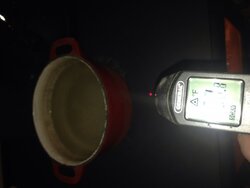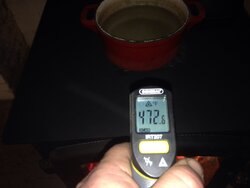Not trying to highjack, it was a normal morning reload decent coal bed maybe 200 stove top. chimney set up 20 ft uninsulated 5.5 in liner in exterior chimney double wall inside. The secondary air control is on the back of the stove the bottom center, it looks like one big square with a divider in the middle, the side toward front of stove is primary with the slider. The side on the back unregulated is the secondary air
Adding firebrick to drolet myraid
- Thread starter deere317
- Start date
-
Active since 1995, Hearth.com is THE place on the internet for free information and advice about wood stoves, pellet stoves and other energy saving equipment.
We strive to provide opinions, articles, discussions and history related to Hearth Products and in a more general sense, energy issues.
We promote the EFFICIENT, RESPONSIBLE, CLEAN and SAFE use of all fuels, whether renewable or fossil.
You are using an out of date browser. It may not display this or other websites correctly.
You should upgrade or use an alternative browser.
You should upgrade or use an alternative browser.
- Status
- Not open for further replies.
ethanhudson
Burning Hunk
I don't think there is a difference. If anything I think its probably better because the upper portion of the stove where the secondary burn occurs stays hotter. Makes sense to me anyway...Pic came out awesome! How have the secondaries and the regular burn been affected by adding the brick?
Huntindog1
Minister of Fire
I don't think there is a difference. If anything I think its probably better because the upper portion of the stove where the secondary burn occurs stays hotter. Makes sense to me anyway...
How many fire brick did you need to do it or do you remember?
ethanhudson
Burning Hunk
I just counted and its 7 total. I think I just bought a pack of them from menards.How many fire brick did you need to do it or do you remember?
Chuck the Canuck
Feeling the Heat
Not trying to highjack, it was a normal morning reload decent coal bed maybe 200 stove top. chimney set up 20 ft uninsulated 5.5 in liner in exterior chimney double wall inside. The secondary air control is on the back of the stove the bottom center, it looks like one big square with a divider in the middle, the side toward front of stove is primary with the slider. The side on the back unregulated is the secondary air
Thanks, I looked and saw what you were referring to. Good to know where I need to go if I ever have to take action to slow things down....
Chuck the Canuck
Feeling the Heat
I don't think there is a difference. If anything I think its probably better because the upper portion of the stove where the secondary burn occurs stays hotter. Makes sense to me anyway...
Yeah, it sure sounds like a plausible explanation to me...
Chuck the Canuck
Feeling the Heat
I suppose the whole idea of having only half the box filled with bricks was so that the stove would radiate heat to beat the band.... and I sure like how it throws the heat; I need it right now (calling for -20 Celsius/-4 Fahrenheit tonight)....
Huntindog1
Minister of Fire
right now I show 550ish stove top and 620 on upper area of the sides with a 675 internal flu temp.
Huntindog1
Minister of Fire
Huntindog1
Minister of Fire
The sides are exposed to the firebox since it doesnt have firebricks so the sides a little bit down your reading the heat of the firebox the top is isolated as the baffle manifold is separating the top plate from the fire box.18" above -maybe 20.. just curious as I often find the upper side of the stove hotter then the top but others report the opposite..house is drafty so I do push it harder then others might be doing though
Huntindog I wonder since you stepped the flue up to eight inch pipe if that could be the reason for the lower pipe temp
Huntindog1
Minister of Fire
That's about the same stove top temp but my flue temp is higher. Wonder why
If you have higher air flow thru stove like extra draw from the flue pulls more air in as the secondary air is fixed opening. Or leaky door gasket adds more air flow then the heat hets flushed up the flue making it hotter.
Huntindog1
Minister of Fire
smaller pipe I think would have higher velocity , on another note you have 25 foot flue which is pretty tall and could cause a strong draw of the flue especially if your flue is insulated and stays warm the entire length. A pipe Damper may help.Huntindog I wonder since you stepped the flue up to eight inch pipe if that could be the reason for the lower pipe temp
ethanhudson
Burning Hunk
I can when I run mine.Can you hear air sucking in the intake when you have the air turned down?
edit: with the air control completely closed you can still hear the stove sucking air, and if you look under the stove on the rear you can see the area on the air intake that remains open even when the control is closed
Huntindog1
Minister of Fire
no, so you must have a strong draw. But I do have some noise if the bypass damper is open and door cracked. Close the bypass and my stove quiets down even with the door still cracked during start ups.Can you hear air sucking in the intake when you have the air turned down?
played around last night a little, more primary air = hotter sides above brick/less secondaries and lower stove top temps and vice-verse - which makes complete senseThe sides are exposed to the firebox since it doesnt have firebricks so the sides a little bit down your reading the heat of the firebox the top is isolated as the baffle manifold is separating the top plate from the fire box.
- Status
- Not open for further replies.
Similar threads
- Replies
- 5
- Views
- 834
- Replies
- 2
- Views
- 137
- Replies
- 16
- Views
- 1K
- Replies
- 18
- Views
- 1K



